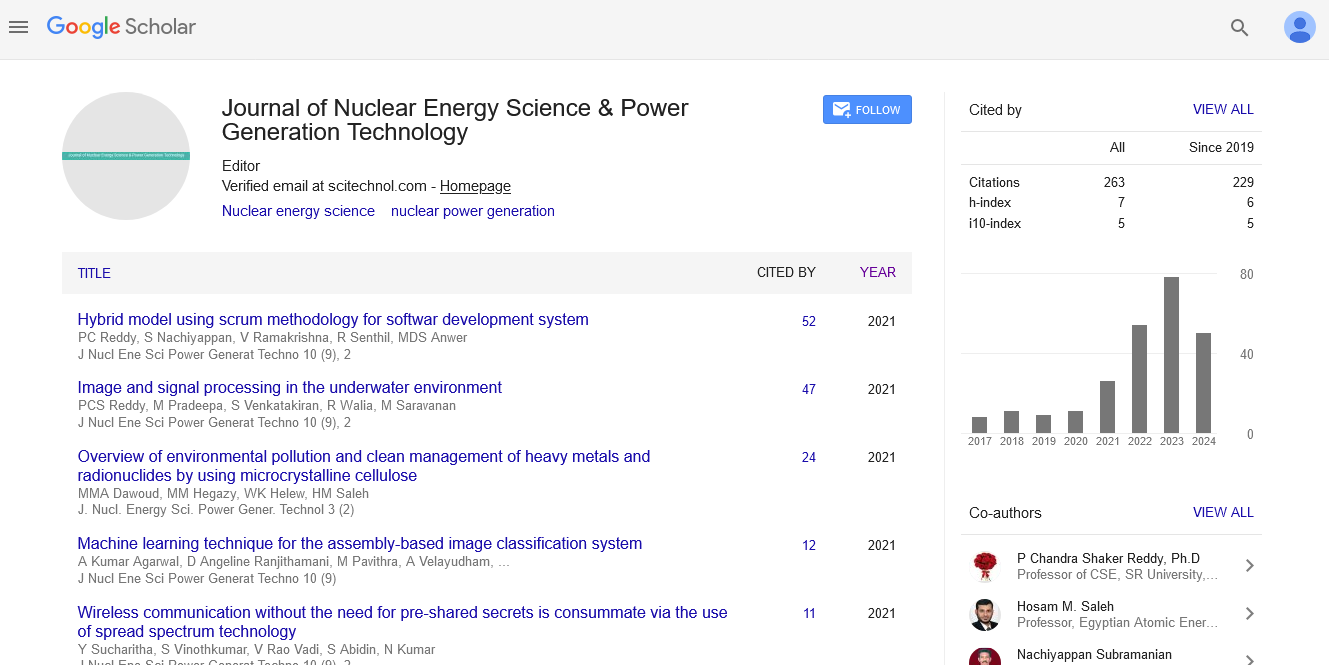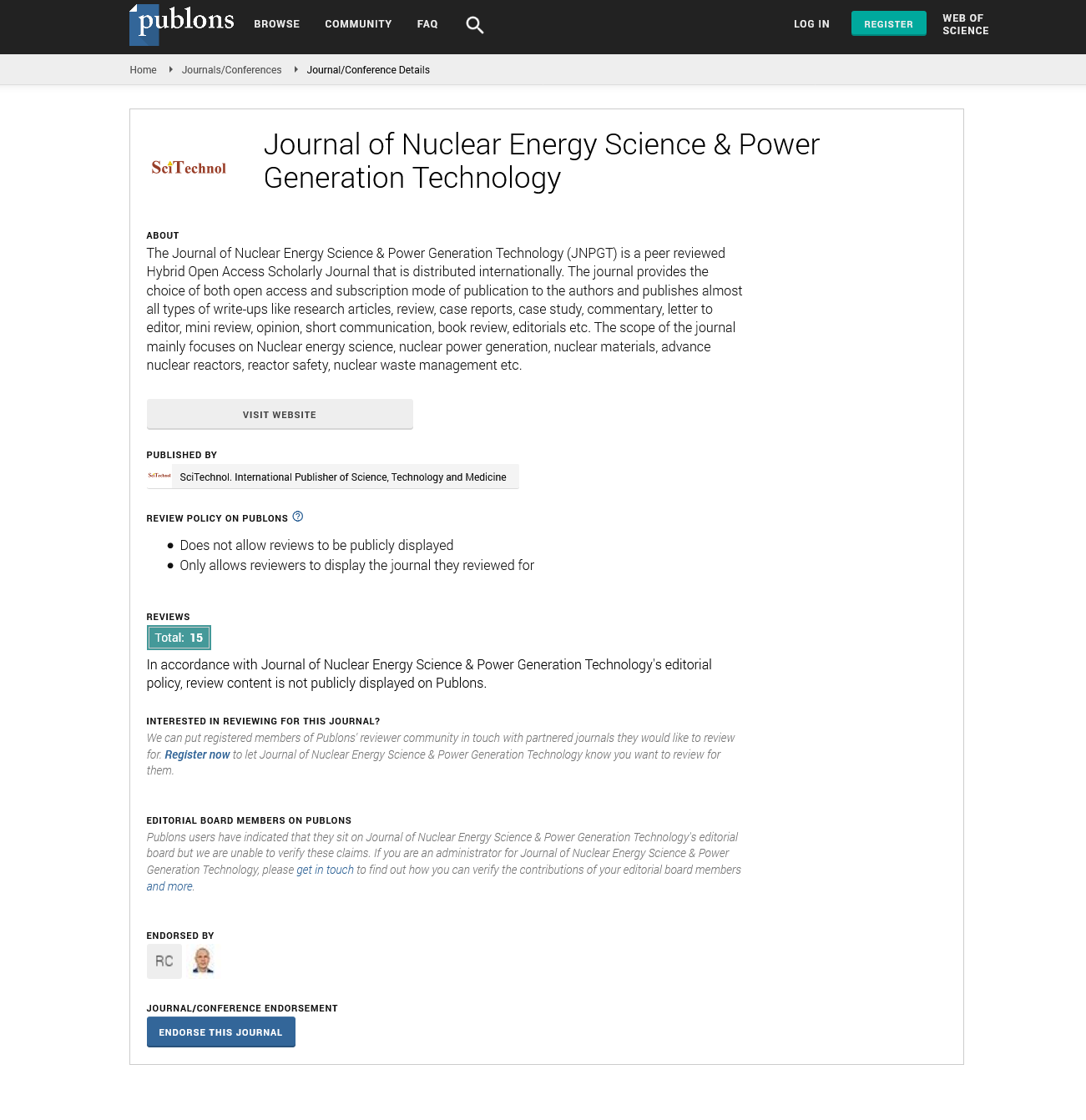Opinion Article, J Nucl Ene Sci Power Generat Technol Vol: 13 Issue: 5
Advancements in High- Temperature Gas-Cooled Reactors: Enhancing Efficiency and Safety in Nuclear Power Generation
Wenyu Siu*
1Department of Nuclear Science and Technology, Harbin Engineering University, Heilongjiang, China
*Corresponding Author: Wenyu Siu,
Department of Nuclear Science and Technology, Harbin Engineering University,
Heilongjiang, China
E-mail: wenyu_sin22@gmail.com
Received date: 26 August, 2024, Manuscript No. JNPGT-24-150414;
Editor assigned date: 28 August, 2024, PreQC No. JNPGT-24-150414 (PQ);
Reviewed date: 11 September, 2024, QC No. JNPGT-24-150414;
Revised date: 18 September, 2024, Manuscript No. JNPGT-24-150414 (R);
Published date: 25 September, 2024, DOI: 10.4172/2325-9809.1000417.
Citation: Siu W (2024) Advancements in High- Temperature Gas-Cooled Reactors: Enhancing Efficiency and Safety in Nuclear Power Generation. J Nucl Ene Sci Power Generat Technol 13:5.
Description
As global demand for clean and reliable energy continues to grow advanced nuclear technologies are in consideration. Among these gascooled reactors stand out due to their potential to enhance safety, efficiency and sustainability in nuclear power generation. High- Temperature Gas Reactors (HTGRs), in particular are leading innovations providing solutions to challenges faced by traditional nuclear reactors. Gas reactors operate using a gaseous coolant most commonly helium, instead of water. They fall under the broader category of Generation IV reactors which focus on safety, sustainability and cost-effectiveness. These reactors utilize graphite as a moderator slowing down neutrons to sustain the nuclear fission reaction and are designed to operate at much higher temperatures than water-cooled reactors. HTGRs for example can reach temperatures up to 1000°C compared to conventional light-water reactors that typically operate around 300°C.
This high-temperature capability provides several advantages such as increased thermal efficiency and the possibility of using waste heat for industrial applications. Moreover, HTGRs are often built as modular units allowing flexibility in power output and scalability. The modular nature also helps in improving construction time and reducing overall costs compared to traditional nuclear power plants. A primary feature of gas reactors is their characteristic safety. Helium, the coolant used in most gas-cooled designs, is chemically inert meaning it doesn’t react with other materials eliminating the risk of explosion or corrosion inside the reactor core. Additionally, helium has excellent heat transfer properties ensuring efficient cooling even at very high temperatures.
One of the most significant safety advantages of gas reactors is their ability to implement passive safety systems. These systems don’t depend on active mechanisms like pumps or external power sources, which could fail in emergency situations. Instead, the reactor design ensures that if the coolant flow is interrupted the reactor naturally cools down due to the high thermal capacity of the graphite moderator and the properties of the reactor's materials. Moreover, gas reactors are designed to be meltdown-resistant. In case of an emergency, such as a loss of coolant the reactor can dissolve heat through natural convection, preventing the reactor core from reaching dangerous temperatures. This contrasts with traditional water-cooled reactors, which require active cooling systems to prevent overheating and potential core damage.
Gas reactors, particularly HTGRs, provide enhanced energy efficiency due to their ability to operate at much higher temperatures. This high-temperature operation allows for more efficient conversion of heat into electricity, resulting in better fuel utilization and reduced waste. Thermal efficiency in gas reactors can approach 50% compared to around 33% in conventional nuclear reactors. In addition to electricity production, the high temperatures produced by HTGRs can be used in industrial processes such as hydrogen production, desalination and petrochemical refining. This makes gas reactors versatile energy sources that can serve multiple sectors while reducing greenhouse gas emissions. In the context of the global shift towards decarbonization, gas reactors represent an attractive option for clean energy generation. The potential for gas-cooled reactors to integrate into the future energy mix is substantial. The modular design of these reactors allows for flexible deployment in various settings, from largescale power plants to decentralized small modular reactors in remote areas.
Conclusion
Gas-cooled reactors, especially HTGRs, represent a significant step forward in nuclear energy innovation. Their combination of safety, efficiency and versatility makes them an attractive option for meeting the increasing global demand for clean energy. By addressing challenges related to commercialization, infrastructure and regulatory approval gas reactors could play an important role in the future energy landscape providing sustainable and reliable power for decades to come. Moreover, regulatory frameworks for advanced reactors, such as HTGRs are still evolving and the nuclear industry must work closely with regulatory bodies to ensure safe deployment. Additionally, their ability to co-generate heat and electricity opens doors to more sustainable industrial applications. However, the widespread deployment of gas reactors faces several challenges. While the technology is promising, commercialization is still in its early stages. The construction of gas reactors requires significant initial investments and the development of specialized infrastructure for gascooled systems is necessary.
 Spanish
Spanish  Chinese
Chinese  Russian
Russian  German
German  French
French  Japanese
Japanese  Portuguese
Portuguese  Hindi
Hindi 

